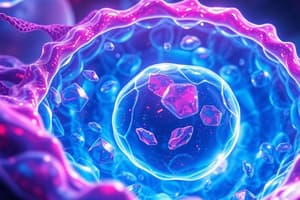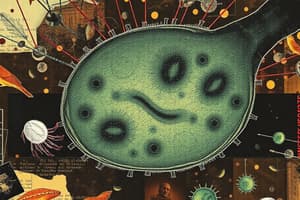Podcast
Questions and Answers
Which of the following is NOT a basic characteristic of a typical animal cell?
Which of the following is NOT a basic characteristic of a typical animal cell?
- Acquires and utilises energy
- Stores hereditary information
- Photosynthesis capability (correct)
- Able to respond to stimuli
What is the total magnification of a compound microscope based on?
What is the total magnification of a compound microscope based on?
- The distance between the lenses
- The size of the specimen
- Product of objective lens and eyepiece (correct)
- The strength of one lens
Who observed the first living cells and referred to them as 'animalcules'?
Who observed the first living cells and referred to them as 'animalcules'?
- Rudolf Virchow
- Robert Hooke
- Felix Dujardin
- Anton Van Leeuwenhoek (correct)
Which of the following is the second postulate of the cell theory?
Which of the following is the second postulate of the cell theory?
Which part of a compound microscope is responsible for adjusting the view of the specimen?
Which part of a compound microscope is responsible for adjusting the view of the specimen?
What type of microscope has multiple lenses?
What type of microscope has multiple lenses?
Which of the following scientists contributed to the cell theory?
Which of the following scientists contributed to the cell theory?
What limitation does a simple microscope have compared to a compound microscope?
What limitation does a simple microscope have compared to a compound microscope?
What is the main role of the nucleus in a eukaryotic cell?
What is the main role of the nucleus in a eukaryotic cell?
What is primarily found in the cytoplasm of a eukaryotic cell?
What is primarily found in the cytoplasm of a eukaryotic cell?
What structure forms the outermost layer of animal cells?
What structure forms the outermost layer of animal cells?
What layer constitutes the basic structure of the cell membrane?
What layer constitutes the basic structure of the cell membrane?
Which characteristic best defines a selectively permeable membrane?
Which characteristic best defines a selectively permeable membrane?
Which of the following components is NOT part of the cytoplasm?
Which of the following components is NOT part of the cytoplasm?
What is one of the primary functions of transport proteins in the cell membrane?
What is one of the primary functions of transport proteins in the cell membrane?
Which type of membrane allows all particles to pass freely?
Which type of membrane allows all particles to pass freely?
What type of cells undergo mitosis?
What type of cells undergo mitosis?
What is the result of a single round of mitosis?
What is the result of a single round of mitosis?
How many nuclear divisions occur during meiosis?
How many nuclear divisions occur during meiosis?
What happens to the chromosome number during meiosis?
What happens to the chromosome number during meiosis?
Which of the following is correct regarding daughter cells produced by meiosis?
Which of the following is correct regarding daughter cells produced by meiosis?
What happens to a cell placed in a hypertonic solution?
What happens to a cell placed in a hypertonic solution?
What describes an isotonic solution in relation to a cell?
What describes an isotonic solution in relation to a cell?
What is the primary function of the rough endoplasmic reticulum (RER)?
What is the primary function of the rough endoplasmic reticulum (RER)?
Which statement correctly describes the Golgi body?
Which statement correctly describes the Golgi body?
What is a key structural characteristic of mitochondria?
What is a key structural characteristic of mitochondria?
What role do chloroplasts play in plant cells?
What role do chloroplasts play in plant cells?
Which statement about smooth endoplasmic reticulum (SER) is correct?
Which statement about smooth endoplasmic reticulum (SER) is correct?
What is one of the functions of the stroma in chloroplasts?
What is one of the functions of the stroma in chloroplasts?
What characterizes a freely permeable membrane?
What characterizes a freely permeable membrane?
What type of transport requires energy to move molecules against their concentration gradient?
What type of transport requires energy to move molecules against their concentration gradient?
Which of the following correctly describes passive transport?
Which of the following correctly describes passive transport?
What role does the cell wall play in plant cells?
What role does the cell wall play in plant cells?
What is the primary composition of the cell wall in plant cells?
What is the primary composition of the cell wall in plant cells?
In a hypotonic solution, what happens to a cell?
In a hypotonic solution, what happens to a cell?
Which type of molecule is primarily transported through passive transport?
Which type of molecule is primarily transported through passive transport?
What structure in fungi serves a similar purpose to the cell wall in plants?
What structure in fungi serves a similar purpose to the cell wall in plants?
Flashcards are hidden until you start studying
Study Notes
Basic Characteristics of Cells
- Cells store hereditary information, reproduce, acquire and utilize energy, and are sites for various biochemical reactions.
- They are capable of responding to stimuli.
Cell Discovery
- Robert Hooke examined cork and identified "cells," which are dead plant cells.
- Anton Van Leeuwenhoek improved microscope design and observed the first living cells, termed "animalcules."
Cell Theory
- Formulated by Schleiden and Schwann, modified by Rudolf Virchow, stating:
- All living organisms are made up of one or more cells.
- The cell is the basic structural and functional unit of life.
- All cells arise from pre-existing cells.
Microscopes
- Instruments designed to magnify small objects, revealing details invisible to the naked eye.
Simple Microscope
- Consists of a single lens with magnification limited to one lens.
Compound Microscope
- Utilizes multiple lenses; total magnification is the product of objective and eyepiece lenses.
Types of Cells
- Cells are categorized into two main groups based on complexity.
Components of a Eukaryotic Cell
- Nucleus: Contains DNA organized into chromosomes; controls growth and metabolism; surrounded by a nuclear envelope.
- Cytoplasm: Jelly-like substance within the cell membrane, mainly comprised of water, salts, proteins, and organelles; site of most biochemical reactions.
- Cell Membrane: Flexible and selectively permeable; outermost layer enclosing the cell.
Cell Membrane
- Composed of phospholipid bilayer and embedded proteins.
- Functions include enclosing cell components and regulating substance passage.
Permeability
- Types of membranes:
- Impermeable: No particles pass.
- Selectively permeable: Specific molecules can cross.
- Freely permeable: All molecules can cross without resistance.
Types of Transport
- Active Transport: Movement against the concentration gradient using cellular energy (ATP).
- Passive Transport: Movement down the concentration gradient without energy expenditure.
Cell Wall
- Plant Cells: Outermost layer providing rigidity, composed of cellulose.
- Other Organisms:
- Fungi: Made of chitin.
- Algae: Consist of cellulose.
- Bacteria: Comprised of peptidoglycan.
Cells in Different Solutions
- Hypotonic Solution: Higher water concentration outside; cells gain water.
- Hypertonic Solution: Lower water concentration outside; cells lose water.
- Isotonic Solution: Equal water concentration; no net movement of water.
Cell Organelles
- Organelles: Subcellular structures with specific functions.
Endoplasmic Reticulum (ER)
- Rough ER: Ribosomes attached; synthesizes proteins and enzymes.
- Smooth ER: No ribosomes; synthesizes lipids and steroids.
Golgi Body
- Composed of membrane-bound sacs (cisternae); packages and transports materials synthesized in the cell.
Mitochondria
- Double-membrane organelle with its own DNA; site of ATP production.
Chloroplasts
- Present in higher plants; contains thylakoids and stroma for photosynthesis.
Cell Division
Mitosis
- Occurs in somatic cells; results in two diploid daughter cells; chromosome number remains the same.
Meiosis
- Occurs in germ cells; results in four haploid daughter cells; chromosome number is halved after two nuclear divisions.
Studying That Suits You
Use AI to generate personalized quizzes and flashcards to suit your learning preferences.



